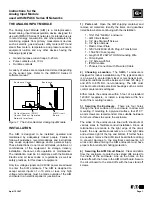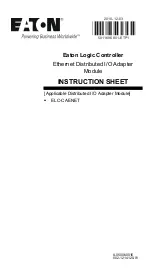
Rev. 9/14/2020
FLB MANUAL
Copyright 2020 Vestil Manufacturing Corp. Page 5 of 7
Connect the load to the FLB in a manner that minimizes load swing when it is lifted off of the ground.
Swinging loads might cause injuries and/or could damage equipment.
INSPECTIONS
Inspections and repairs should only be performed by qualified persons. Compare the results of each
inspection to the
RECORD
OF SATISFACTORY CONDITION
(the “RECORD”). Do not use the lifter
unless all parts are in satisfactory condition. Replace parts that are not in satisfactory condition before
using the lifter again.
DON’T GUESS!
If you have any questions about the condition of your lifter,
speak with
TECHNICAL SERVICE
personnel
.
The phone number is provided on the cover page of
this manual.
Never make temporary repairs of damaged or missing parts
. Only use manufacturer-
approved replacement parts. Deformities, cracks, and severe wear of the frame weldment require
immediate replacement of the entire unit
.
If you determine that any part of the lifting beam is not in satisfactory condition, restore the
beam to satisfactory condition BEFORE using it again.
1.
Before each use
– Visually examine the beam for cracks, severe rusting/corrosion, damaged hooks
and/or shackle, and damaged safety strap or its snap hook.
2.
Monthly inspection
— At least once per month, and before using the beam for the first time, inspect
the following components for conditions that might interfere with normal operation.
Frame weldment and tension plates: Fork slots should be square and solid. The tension plates should
be able to move up-and-down but should be prevented from sliding free of the frame weldment by
spring pins (64247). Excessive wear or damage (or indications of metal fatigue) to any portion of the
fork pockets, support frame, beam or beam sleeve.
Safety strap: Closely examine the strap and the snap hook at the free end of the strap. Check the strap
for thinned, frayed, torn, or significantly worn areas. The snap hook at the end of the strap should return
to the closed position automatically.
Lifting hooks and clevis pins: Examine both hooks. Record the measurement of the throat opening of
each hook and compare the measurements with those in the
. Replace a hook if its throat
opening is more than 15 percent wider than the original throat opening measurement, or if the hook is
twisted more than 10° from the plane of the unbent hook. Hook latches should close automatically.
Examine clevis pins (33-112-023) and cotter pins that attach the hooks to the frame. Immediately
replace a clevis pin that is bent, cracked, and/or deformed or damaged in any way.
Lifting shackle: Examine the shackle. Measure the throat opening. Compare the measurement with the
measurement in the
. Tighten the shackle pin. The shackle should be securely attached to the
underside of the frame. Immediately replace the shackle if it, or the shackle pin, is cracked, warped, or
significantly worn.
Locking bolts: Each locking bolt winds into a square nut under the top of a tension plate. Make sure that
each bolt winds through its square nut. Mount the beam on the forks of your lift truck. Confirm that you
can bring the end of each bolt into solid contact with the top surface of each fork. Doing so should also
cause each tension plate to firmly press against the underside of the corresponding fork.
Labeling: The product should always be labeled substantially as shown in the
p. 6. Replace any label that is damaged, significantly faded, or not easily readable from a reasonable
distance.
MAINTENANCE
Implement a maintenance program to ensure that the beam remains in normal operating condition.
The following steps should be utilized in conjunction with maintenance procedures applicable to fork
truck attachments provided in the most recent edition of ANSI B56.1.
Step 1: Tag the beam, “Out of Service.”
Step 2: Remove dirt and other matter from all surfaces
.
(see p. 5). If severe deformities, corrosion, rusting, or excessive
wear of structural members is found, immediately and permanently remove the device from service.
Step 4: Perform all necessary adjustments, replacements and/or repairs but DO NOT modify the beam
.
!

























